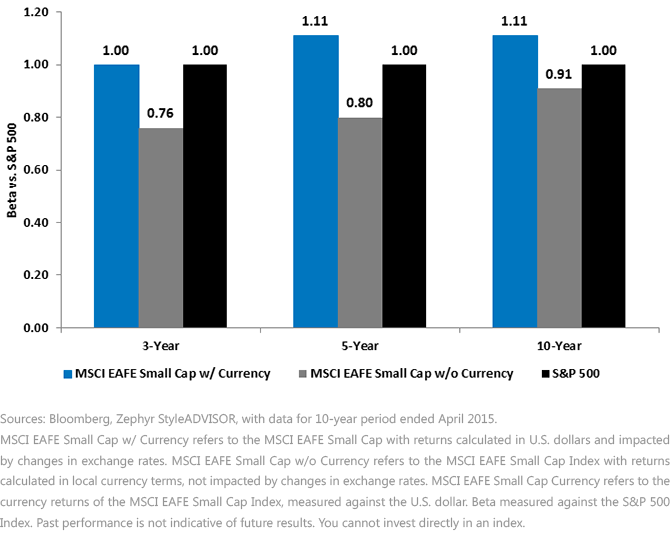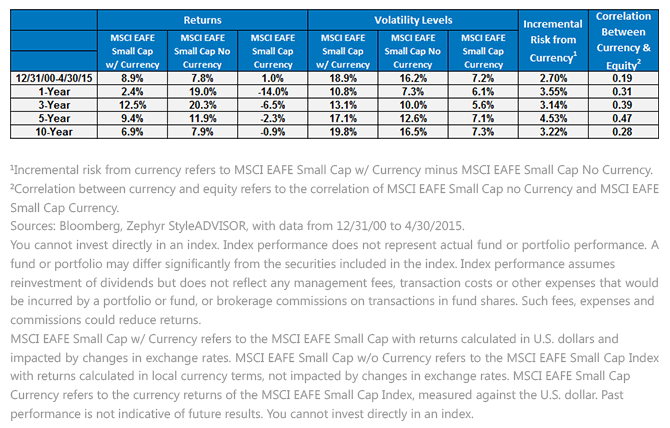Explore the Core with International Small Caps: Hedged or Unhedged


 Using the beta statistic measured against the S&P 500 Index—one of the most widely followed for any U.S. equity investor—we can see that the MSCI EAFE Small Cap with no currency exposure exhibited a value below 1.00, meaning that it had lower market risk than the S&P 500 Index, across all time periods displayed in figure 1. The MSCI EAFE Small Cap with currency—an index of the same underlying equities—showed a beta at or above 1.00 when compared with the S&P 500 Index over the same time periods.
Figure 2: Currency Exposure Significantly Raises Volatility
Using the beta statistic measured against the S&P 500 Index—one of the most widely followed for any U.S. equity investor—we can see that the MSCI EAFE Small Cap with no currency exposure exhibited a value below 1.00, meaning that it had lower market risk than the S&P 500 Index, across all time periods displayed in figure 1. The MSCI EAFE Small Cap with currency—an index of the same underlying equities—showed a beta at or above 1.00 when compared with the S&P 500 Index over the same time periods.
Figure 2: Currency Exposure Significantly Raises Volatility
 Over the last 10 years, the incremental risk from having the currency exposure added about 3.2% per year to the annualized volatility; yet the currency exposure added nothing to the total return of the portfolio (it actually amounted to nearly a 1 percentage point annualized drag on the index). This raises a natural question: why take on risk to an “asset class” if there is no expected return?
The answer may be that developed world currencies are not really an asset class at all. Therefore, going forward, investors may be interested in targeting local market returns—through a currency-hedged approach. In the case of developed world small-cap stocks, the evidence suggests that investors might improve their risk profiles by doing so.
Introducing the WisdomTree International Hedged SmallCap Dividend Index
WisdomTree recently launched a new index that measures the performance of international small caps while mitigating foreign currency risk. The WisdomTree International Hedged SmallCap Dividend Index (WTISDIH)—a broad measure of developed world small-cap companies—hedges fluctuations in foreign currencies against the U.S. dollar. The cost to hedge, essentially the annualized difference in one-month interest rates between the U.S. and each targeted market, was 0.46%2 as of April 30, 2015.
One way to generate higher risk-adjusted returns is to reduce risk, which, as we have shown, may be achieved by hedging currency exposure. The other way is to increase returns. This may be achieved by weighting equity markets by measures other than market capitalization. On this point, it’s important to note that WisdomTree has been illustrating what happens when one weights equity markets based on dividends for nearly a decade now. In May 2006, WisdomTree launched the unhedged version of this Index when it introduced international small-cap investing to the ETF industry. The currency-hedged Index, WTISDIH, and the unhedged WisdomTree International SmallCap Dividend Index (WTISDI) share the same selection and weighting rules. Constituents are selected annually based on their market capitalizations; they are weighted once a year based on the U.S. dollar value of the cash dividends they have paid to investors over the prior year. The Indexes are rebalanced each year in June, and country and sector exposures are capped at 25% at the annual rebalance.
So the performance of the underlying stocks—with currency risk—is already known. Since its inception in 2006, WTISDI has generated returns that have exceeded those of the capitalization-weighted MSCI EAFE Small Cap Index by roughly 170 basis point (bps) over the same period.3
For investors interested in the strategies, the WisdomTree International Hedged SmallCap Dividend Fund (HDLS) is designed to track the performance of the WisdomTree International Hedged SmallCap Dividend Index before fees and expenses. For more information on the exposures of this Fund, please click here.
1International Small Caps refers to the MSCI EAFE Small Cap Index.
2Source: Bloomberg, as of 4/30/2015.
3Source: Bloomberg, as of 3/31/15.
Over the last 10 years, the incremental risk from having the currency exposure added about 3.2% per year to the annualized volatility; yet the currency exposure added nothing to the total return of the portfolio (it actually amounted to nearly a 1 percentage point annualized drag on the index). This raises a natural question: why take on risk to an “asset class” if there is no expected return?
The answer may be that developed world currencies are not really an asset class at all. Therefore, going forward, investors may be interested in targeting local market returns—through a currency-hedged approach. In the case of developed world small-cap stocks, the evidence suggests that investors might improve their risk profiles by doing so.
Introducing the WisdomTree International Hedged SmallCap Dividend Index
WisdomTree recently launched a new index that measures the performance of international small caps while mitigating foreign currency risk. The WisdomTree International Hedged SmallCap Dividend Index (WTISDIH)—a broad measure of developed world small-cap companies—hedges fluctuations in foreign currencies against the U.S. dollar. The cost to hedge, essentially the annualized difference in one-month interest rates between the U.S. and each targeted market, was 0.46%2 as of April 30, 2015.
One way to generate higher risk-adjusted returns is to reduce risk, which, as we have shown, may be achieved by hedging currency exposure. The other way is to increase returns. This may be achieved by weighting equity markets by measures other than market capitalization. On this point, it’s important to note that WisdomTree has been illustrating what happens when one weights equity markets based on dividends for nearly a decade now. In May 2006, WisdomTree launched the unhedged version of this Index when it introduced international small-cap investing to the ETF industry. The currency-hedged Index, WTISDIH, and the unhedged WisdomTree International SmallCap Dividend Index (WTISDI) share the same selection and weighting rules. Constituents are selected annually based on their market capitalizations; they are weighted once a year based on the U.S. dollar value of the cash dividends they have paid to investors over the prior year. The Indexes are rebalanced each year in June, and country and sector exposures are capped at 25% at the annual rebalance.
So the performance of the underlying stocks—with currency risk—is already known. Since its inception in 2006, WTISDI has generated returns that have exceeded those of the capitalization-weighted MSCI EAFE Small Cap Index by roughly 170 basis point (bps) over the same period.3
For investors interested in the strategies, the WisdomTree International Hedged SmallCap Dividend Fund (HDLS) is designed to track the performance of the WisdomTree International Hedged SmallCap Dividend Index before fees and expenses. For more information on the exposures of this Fund, please click here.
1International Small Caps refers to the MSCI EAFE Small Cap Index.
2Source: Bloomberg, as of 4/30/2015.
3Source: Bloomberg, as of 3/31/15.
Important Risks Related to this Article
This Fund is new and has limited operating history. Hedging can help returns when a foreign currency depreciates against the U.S. dollar but can hurt when the foreign currency appreciates against the U.S. dollar. There are risks associated with investing, including possible loss of principal. Foreign investing involves special risks, such as risk of loss from currency fluctuation or political or economic uncertainty. Investments in emerging markets are generally less liquid and less efficient than investments in developed markets and are subject to additional risks, such as risks of adverse governmental regulation and intervention or political developments. To the extent the Fund invests a significant portion of its assets in the securities of companies of a single country or region, it is likely to be impacted by the events or conditions affecting that country or region. Funds focusing their investments on certain sectors and/or smaller companies increase their vulnerability to any single economic or regulatory development. This may result in greater share price volatility. Dividends are not guaranteed, and a company currently paying dividends may cease paying dividends at any time. The Fund uses various strategies to attempt to minimize the impact of changes in foreign currency against the U.S. dollar, which may not be successful. Derivative investments can be volatile, and these investments may be less liquid than securities, and more sensitive to the effects of varied economic conditions. The Fund invests in the securities included in, or representative of, its Index regardless of their investment merit, and the Fund does not attempt to outperform its Index or take defensive positions in declining markets. Due to the investment strategy of this Fund, it may make higher capital gain distributions than other ETFs. Please read the Fund’s prospectus for specific details regarding the Fund’s risk profile.


